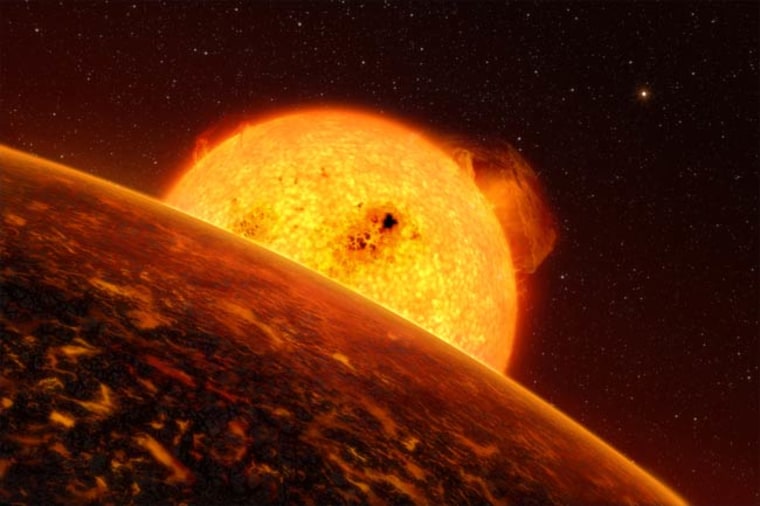A rocky extrasolar planet known to have wild temperature extremes may also be covered in volcanoes.
The planet, known as CoRoT-7b, was confirmed to be orbiting a star some 480 light-years away in October. While it has a rocky surface, it is unlikely to harbor life because it sits so close to its parent star. Its surface temperatures may be as high as 4,000 degrees Fahrenheit (2,200 degrees Celsius) on its day side and as low as minus 350 F (minus 210 C) on its night side.
New evidence suggests that this forbidding world is even more unfriendly to life: Unless the planet's orbit is almost perfectly circular, it could be undergoing fierce volcanic eruptions, astronomers announced here at the 215th meeting of the American Astronomical Society.
CoRoT-7b could even be more volcanically active than Jupiter's moon Io, which has more than 400 volcanoes and is the most volcanically active body in our solar system.
"If conditions are what we speculate, then CoRoT-7b could have multiple volcanoes going off continuously and magma flowing all over the surface," said Rory Barnes of the University of Washington in Seattle.
Volcanism has implications for the development of life, because it constantly remakes a planet's surface, making it hard for any organisms to gain a foothold. Past studies of CoRoT-7b also suggest the planet's atmosphere is made of vaporized rock that may rain down on the surface from time to time.
Barnes and his colleagues think that CoRoT-7b may be so volcanically active partly because it sits so close to its sun, at a distance of just 1.6 million miles (2.5 million kilometers), or 60 times closer than Earth is to the sun.
Any deviations from a circular orbit — even just 155 miles (250 kilometers), according to Barnes' calculations — would cause CoRoT-7b to receive a significant gravitational tug from the next planet out in the system. These tidal tugs would cause the surface of the planet to flex and distort, which would trigger volcanism.
Earth also experiences tidal forces, but its oceans absorb this energy.
"CoRoT-7b most certainly has no oceans. A planet on a non-circular orbit experiences different amounts of gravitational force at different points along the orbit, feeling the strongest gravitational pull when it is closest to the star and the weakest when it is most distant," Barnes explained. "As the planet moves between these two points, it stretches and relaxes. This flexing produces friction that heats the interior of the planet, resulting in volcanism on the surface."
